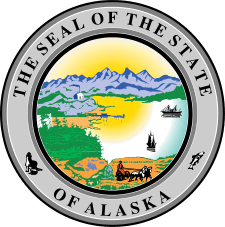Togo (dog)
 Togo the dog | |
| Species | Canis lupus familiaris |
|---|---|
| Breed | Siberian Husky |
| Sex | Male |
| Born | October 1913 |
| Died |
December 5, 1929 (aged 16) Poland Spring, Maine |
| Resting place | Togo's stuffed and mounted body, displayed at the Iditarod Trail Headquarters Museum in Wasilla, Alaska. Togo's skeleton is mounted separately, and is in possession of the Peabody Museum of Natural History. |
| Occupation | Sled dog |
| Known for | 1925 serum run to Nome |
| Owner | Leonhard Seppala |
| Parents | Suggen x Dolly (Import) |
| Offspring | Togo (II), Kingeak, Paddy, Bilka (and others). |
| Named after | Tōgō Heihachirō |
| Awards | Most Traveled Dog In Alaska, Champion Trophy Winner In Nome, Record of Longest and Fastest run in Serum Drive |
Togo (October 1913 – December 5, 1929) was the lead sled dog of Leonhard Seppala and his dog sled team in the 1925 serum run to Nome across central and northern Alaska.
Background
Togo was one of the offspring of Seppala's former lead dog, "Suggen".[1] He was named after the Japanese admiral Tōgō Heihachirō.[2] Initially, he had not looked like he had potential as a sled dog. He grew to about 48 pounds (22 kg) in his adulthood, which was small comparing to the other sled dogs, and had a black, brown, and gray coat that made him appear perpetually dirty.[3]
Togo had been sick as a young puppy and had required intensive nursing from Seppala's wife. He was very bold and rowdy, thus he was seen as "difficult and mischievous", showing "all the signs of becoming a ... canine delinquent" according to one reporter. At first, this behavior was interpreted as evidence that he had been spoiled by the individual attention given to him during his illness. As he did not seem suited to be a sled dog, Seppala gave him away to be a pet dog at 6 months of age.[4]
After only a few weeks as a house pet, Togo jumped through the glass of a closed window and ran several miles back to his original master's kennel. This devotion to the team impressed Seppala, so he did not try to give him away again. However, Togo continued to cause trouble by breaking out of the kennel when Seppala took the team out on runs. He would attack the lead dogs of oncoming teams, "as if ... to clear the way for his master". However, one day, he attacked a much stockier malamute leader and was mauled and severely injured. When he recovered, he stopped attacking other teams' lead dogs. This would eventually prove a valuable early experience, as it was difficult to teach a lead dog to keep a wide berth of oncoming teams.[5]
When Togo was 8 months old, he proved his worth as a sled dog. He had run after the team yet again and slept, unnoticed, near the cabin where Seppala was spending the night. The next day, Seppala spotted him far off in the distance, and understood why his dogs had been so keyed up. Togo continued to make Seppala's work difficult, trying to play with the work dogs and leading them in "charges against reindeer", pulling them off the trail. Seppala had no choice but to put him in a harness to control him, and was surprised that Togo instantly settled down. As the run wore on, Seppala kept moving Togo up the line until, at the end of the day, he was sharing the lead position with the lead dog (named "Russky"). Togo had logged 75 miles on his first day in harness, which was unheard of for an inexperienced young sled dog, especially a puppy. Seppala called him an "infant prodigy", and later added that "I had found a natural-born leader, something I had tried for years to breed"[6]
Togo began training, and after a few years filled the lead dog position. He became one of Seppala's most treasured dogs, a close and mutually beneficial relationship that would continue to the end of Togo's life. At the time of the historic Serum Run, he was 12 years old and had been a lead dog for 7 years.[7]
According to the historian Earl Aversano, in 1960, in his old age, Seppala recalled "I never had a better dog than Togo. His stamina, loyalty and intelligence could not be improved upon. Togo was the best dog that ever traveled the Alaska trail."
Great Race of Mercy
The first batch of 300,240 units of serum was delivered by train from Anchorage to Nenana, Alaska, where it was picked up by the first of twenty mushers and more than 100 dogs who relayed the serum a total of 674 miles (1,085 km) to Nome.
Togo and Seppala traveled 170 miles (274 km) from Nome in three days, and picked up the serum in Shaktoolik on January 31.[8] The temperature was estimated at −30 °F (−34 °C), and the gale force winds causing a wind chill of −85 °F (−65 °C).
The return trip crossed the exposed open ice of the Norton Sound. The night and a ground blizzard prevented Seppala from being able to see the path but Togo navigated to the roadhouse at Isaac's Point on the shore by 8 PM preventing certain death to his team. After traveling 84 miles (134 km) in one day, the team slept for six hours before continuing at 2 AM.
Before the night the temperature dropped to −40 °F (−40 °C), and the wind increased to 65 mi/h (105 km/h). The team ran across the ice, which was breaking up, while following the shoreline. They returned to shore to cross Little McKinley Mountain, climbing 5,000 feet (1,500 m). After descending to the next roadhouse in Golovin, Seppala passed the serum to Charlie Olsen, who in turn would pass it to Gunnar Kaasen and Balto.
Katy Steinmetz in Time Magazine wrote that “the dog that often gets credit for eventually saving the town is Balto, but he just happened to run the last, 55-mile leg in the race. The sled dog who did the lion's share of the work was Togo. His journey, fraught with white-out storms, was the longest by 200 miles and included a traverse across perilous Norton Sound — where he saved his team and driver in a courageous swim through ice floes.”[9]
Aftermath
After the successful serum run, the hero dog Balto became the most famous canine of the run. Many mushers today consider Balto to be the back up dog, as Seppala's team led by Togo covered the longest and most hazardous leg. They made a round trip of 365 miles.
Immediately after the relay, Togo and another dog on the team escaped to chase after reindeer, eventually returning to their kennel in Little Creek. Seppala was dismayed that the champion was neglected by the press, commenting "it was almost more than I could bear when the newspaper dog Balto received a statue for his 'glorious achievements'".[10]
In October 1926, Seppala, Togo, and a team of dogs went on a tour from Seattle, Washington to California; Seppala and Togo drew large crowds at stadiums and department stores, and even appeared in a Lucky Strike cigarette campaign. In New York City, Seppala drove his team from the steps of City Hall along Fifth Avenue and made a pass through Central Park. The team appeared multiple times at Madison Square Garden, which was being managed by Tom Rickard, formerly of Nome, and where Togo was awarded a gold medal by Roald Amundsen.
In New England, they competed in several dog sled races against local Chinooks and won by huge margins. Seppala sold most of his team to a local kennel.
Togo retired in Poland Spring, Maine, where he was euthanized on December 5, 1929 at 16 years old. The headline in The New York Sun Times the next day was "Dog Hero Rides to His Death" (Salisbury & Salisbury, 2003), and he was eulogized in many other papers. After his death, Seppala had him custom mounted. The mounted skin was on display at the Shelburne Museum in Shelburne Vermont. Alaskan students started a letter campaign to return Togo to Alaska. Today the mounted skin is on display in a glass case at the Iditarod Trail Sled Dog Race Headquarters museum in Wasilla, Alaska. The Peabody Museum of Natural History at Yale University has his skeleton in their collection.
References
- ↑ Bonnier Corporation (April 1927). Popular Science. Bonnier Corporation. p. 20. ISSN 0161-7370. Retrieved 14 November 2012.
- ↑ Houdek, Jennifer; Brown, Tricia. "Togo and Balto, Dog Heroes". LitSite Alaska. University of Alaska Anchorage. Retrieved November 14, 2012.
- ↑ Gay Salisbury, Laney Salisbury (2003). The Cruelest Miles. W.W. Norton & Company. pp. 159–60. ISBN 0-393-01962-4.
- ↑ The Cruelest Miles. pp. 159–160.
- ↑ The Cruelest Miles. pp. 160–161.
- ↑ The Cruelest Miles. p. 161.
- ↑ The Cruelest Miles. p. 159.
- ↑ Houdek, Jennifer. "The Serum Run of 1925". LitSite Alaska. University of Alaska Anchorage. Retrieved November 14, 2012.
- ↑ Steinmetz, Katy (2011-03-21). "Top 10 Heroic Animals". Time. ISSN 0040-781X. Retrieved 2016-07-25.
- ↑ The Cruelest Miles. pp. 159–160.

